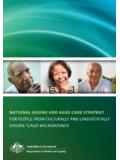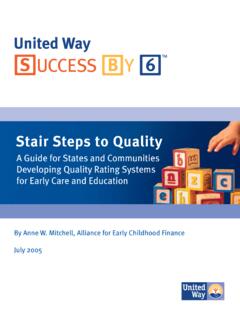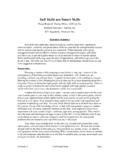Transcription of Creating Innovative Models of Clinical Nursing Education
1 ABSTRACTA lthough Nursing care has changed signifi cantly over the past 30 years, methods to clinically train Nursing stu-dents have not. The traditional model of Clinical Nursing Education , where a faculty member oversees a group of six to eight students on an acute care unit for a 4- to 8-hour shift, provides a haphazard approach to learning. A need exists to fi nd Innovative ways to eff ectively train more nurs-ing students to better prepare them for today s health care environment. Using a change framework, seven approaches to Clinical Nursing Education were created through academic practice partnerships.
2 These approaches may increase the eff ectiveness and effi ciency of the Clinical Nursing Education severe Nursing shortage is predicted over the next 20 years, fueled by Nursing workforce retirements and an increase in the aging population (American Associa-tion of Colleges of Nursing , 2012). Despite this, Nursing pro-grams in the United States are turning away qualifi ed Nursing applications at alarming rates. In 2011, 75,587 qualifi ed appli-cations were denied admission into baccalaureate Nursing pro-grams. A major reason for this capacity bottleneck was a lack of Clinical teaching sites for Nursing students (American Associa-tion of Colleges of Nursing , 2012).
3 Although Nursing care has changed signifi cantly over the past 30 years, the methods to clinically educate Nursing stu-dents have not (Tanner, 2006). The current Models of Clinical Nursing Education provide a haphazard approach to learning, depending on the Clinical unit and the patient census; there-fore, learning experiences are varied among students. Inno-vative ways to effectively educate more Nursing students are needed to better prepare them for the current health care en-vironment. The purpose of this article is to outline a frame-work for Clinical Education innovation that has the potential to increase the effectiveness and effi ciency of the Clinical Nursing Education system.
4 In addition, this article provides a description of the application of the framework that was used to create new Models of Clinical Nursing Education through academic practice authors of two signifi cant studies urged the Nursing profession to rethink Clinical Nursing Education . In the publi-cation, Educating Nurses: A Call for Radical Transformation, Benner, Sutphen, Leonard, and Day (2010) argued that clini-cal experiences should occur in a variety of settings, not just in acute care units. They concluded that classroom learning should be contextual and linked directly to Clinical learning. The landmark report, The Future of Nursing : Leading Change, Advancing Health (Institute of Medicine, 2011) includes a call to redesign the Nursing educational system to better meet the demands of the current and future Nursing practice environ-ment.
5 This redesign includes increasing Nursing students community-based experiences and exposing students to com-plex health care issues, such as those found in long-term care settings. That report also called for a blurring of the demar- Creating Innovative Models of Clinical Nursing EducationVictoria Niederhauser, DrPH, RN; Mary Schoessler, EdD, RN-BC; Paula Marie Gubrud-Howe, EdD, RN, FAAN; Lois Magnussen, EdD, APRN; and Estelle Codier, PhD, RNReceived: October 3, 2011 Accepted: June 27, 2012 Posted Online: October 11, 2012Dr. Niederhauser is Dean and Professor, College of Nursing , University of Tennessee Knoxville, Knoxville, Tennessee; Dr.
6 Schoessler is Assistant Professor, and Dr. Gubrud-Howe is Senior Associate Dean for Education and Statewide Programs, Oregon Health & Science University, School of Nursing , Portland, Oregon; and Dr. Magnussen is Professor (retired), and Dr. Codier is Assistant Professor, School of Nursing and Dental Hygiene, University of Hawaii at Manoa, Honolulu, project was funded by the Robert Wood Johnson Foundation, Ex-ecutive Nurse Fellows Program, and the Hawaii State Center for Schoessler and Dr. Gubrud-Howe received honoraria and travel support from the University of Hawaii. The remaining authors have dis-closed no potential confl icts of interest, fi nancial or otherwise.
7 Address correspondence to Victoria Niederhauser, DrPH, RN, Dean and Professor, College of Nursing , University of Tennessee Knoxville, 1200 Volunteer Boulevard, Knoxville, TN 37996-4180; e-mail: of Nursing Education Vol. 51, No. X, 20121 Innovative Clinical Models cation between didactic Nursing classes and Clinical Nursing INNOVATIONK nowing there must be a better, more Innovative way to ed-ucate Nursing students in Clinical settings, we initiated a proj-ect, using a change framework (Kotter & Rathgeber, 2005) to identify and test new Models of Clinical Nursing Education , with the goals of increasing Clinical capacity, lowering costs or using the same fi nancial profi le, and Creating more targeted and Innovative learning activities for Nursing students.
8 This was achieved through a collaborative approach between nurs-ing academics and Nursing practice by the provision of funding to develop, implement, and evaluate pilot Models for Clinical Nursing Education . The aims of this project included improv-ing Clinical Nursing educational outcomes, increasing Nursing enrollment capacity, and developing nontraditional Clinical placements for Nursing students. The project emphasized a collaborative academic practice partnership as a strategy for Creating Innovative Clinical learning opportunities. The overall evaluation plan for this project used formative and summative evaluation methodologies to determine the effect of each pilot approach on Clinical Nursing Education .
9 The evaluation plan also addressed the return on investment in terms of effi ciency (cost and Clinical site availability) and effectiveness (quality and satisfaction).Kotter and Rathgeber (2005) argued that for change to be successful, one must undertake a series of eight thoughtful steps. The fi rst two steps set the stage for change to occur and include Creating a sense of urgency and establishing a group of people to guide the change process. The next step creates a vision for change. The next four steps involve making change happen and include communicating the vision, empowering others to lead change, acknowledging short-term wins, and perseverance.
10 The fi nal step targets ways to make change last (Kotter & Rathgeber, 2005; Kotter, 2006). These eight steps provided a solid framework for implementing our Clinical Nursing Education THE STAGE FOR CHANGE: Creating URGENCY AND DEVELOPING A GUIDING TEAMTo engage key stakeholders and create a sense of urgency for Clinical Nursing Education redesign, a series of presentations were held at multiple health care facilities throughout the state of Hawaii. In addition to individualized presentations, a Nursing Education Redesign Summit, with more than 90 nurses, nurse leaders, and faculty members, held in May 2009, brought inter-ested stakeholders together at one event.






